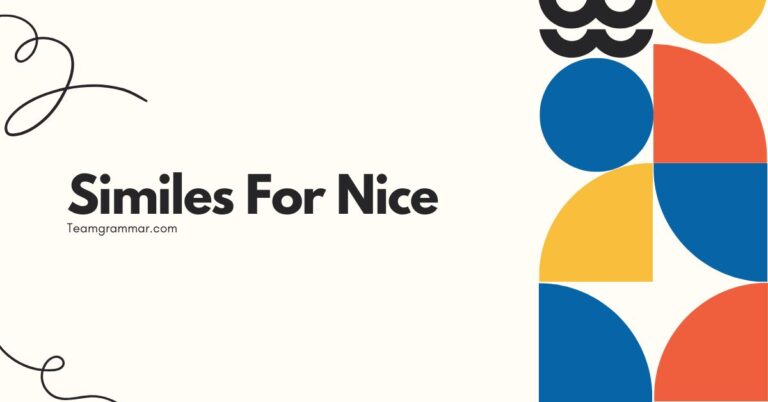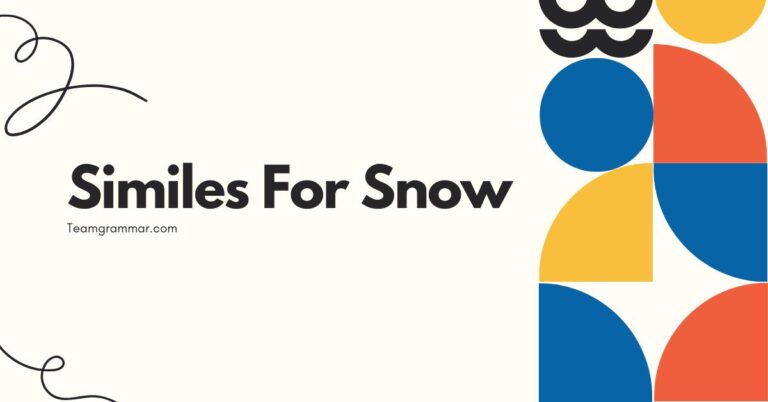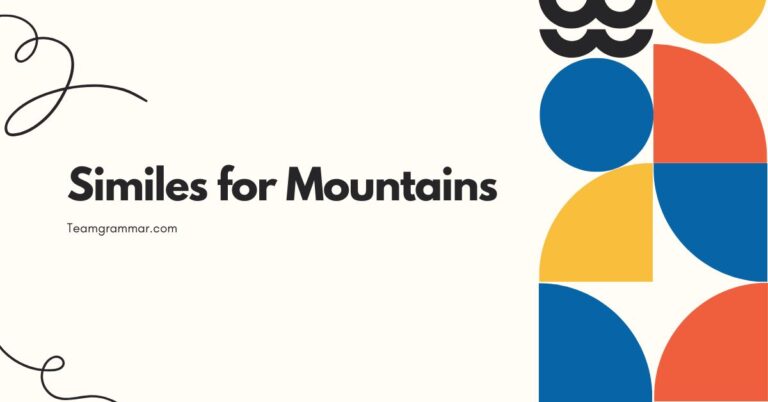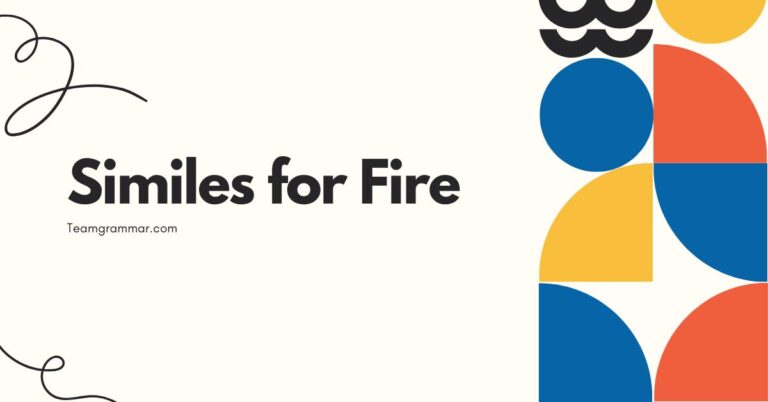30 Similes for Winter: Mastering Figurative Language
Understanding similes is crucial for enhancing your descriptive writing and comprehension skills. Similes allow you to create vivid imagery and connect seemingly unrelated concepts, enriching your vocabulary and making your writing more engaging.
This article will comprehensively explore similes, specifically focusing on their use in describing winter. Whether you’re a student, writer, or English language learner, this guide will equip you with the knowledge and tools to effectively use similes to capture the essence of winter in your writing.
Table of Contents
- Introduction
- Definition of Similes
- Structural Breakdown of Similes
- Types of Similes
- Examples of Similes for Winter
- Usage Rules for Similes
- Common Mistakes with Similes
- Practice Exercises
- Advanced Topics: Metaphors vs. Similes
- Frequently Asked Questions
- Conclusion
Definition of Similes
A simile is a figure of speech that directly compares two different things, typically using the words “like” or “as.” The purpose of a simile is to create a vivid image or to emphasize a particular quality shared by the two things being compared. Unlike a metaphor, which states that one thing *is* another, a simile acknowledges the comparison with explicit connecting words.
Similes are used to make descriptions more engaging and relatable. They help the reader understand a concept by associating it with something familiar.
In the context of describing winter, similes can evoke the coldness, beauty, and unique characteristics of the season.
The function of a simile is primarily descriptive and illustrative. It allows writers to express complex ideas or feelings in a more accessible and imaginative way.
Similes can also add depth and nuance to writing, making it more impactful and memorable. They are frequently used in poetry, prose, and everyday conversation to enrich language.
Structural Breakdown of Similes
A simile typically consists of three main components:
- The subject: The thing being described.
- The connecting word: Usually “like” or “as,” but can also be “than” in some contexts.
- The object of comparison: The thing to which the subject is being compared.
The basic structure can be represented as: Subject + Connecting Word + Object of Comparison.
For example, in the simile “The snow fell like feathers,” the subject is “snow,” the connecting word is “like,” and the object of comparison is “feathers.” This structure allows for a clear and direct comparison, highlighting the gentle and delicate nature of the falling snow.
Another example is, “The wind was as sharp as a knife.” Here, the ‘wind’ is the subject, ‘as’ is the connecting word, and ‘a knife’ is the object of comparison. The simile creates a sense of the wind’s piercing coldness.
Understanding this structure is essential for creating effective similes. By carefully choosing the subject, connecting word, and object of comparison, writers can craft powerful and evocative descriptions.
Types of Similes
While all similes share the same basic structure, they can be categorized based on the type of comparison they make and the effect they create.
Descriptive Similes
These similes focus on physical characteristics, such as appearance, texture, or sound. They create vivid images and help the reader visualize the subject more clearly.
Emotional Similes
Emotional similes convey feelings or emotions by comparing them to something tangible or relatable. They help the reader understand the emotional state of the subject.
Action Similes
Action similes describe actions or behaviors by comparing them to other actions or behaviors. They add dynamism and movement to the description.
Exaggerated Similes (Hyperbolic Similes)
These similes use exaggeration to emphasize a particular quality or characteristic. They are often used for humorous or dramatic effect.
Understated Similes
Understated similes use understatement to create a subtle or ironic effect. They can be more impactful because they rely on the reader to infer the comparison.
Examples of Similes for Winter
Here are numerous examples of similes specifically crafted to describe various aspects of winter, categorized to illustrate their diverse applications.
Descriptive Similes for Winter
The following table provides examples of descriptive similes that capture the visual and sensory aspects of winter.
| Simile | Explanation |
|---|---|
| The snow was as white as a bleached sheet. | Emphasizes the pure, bright whiteness of the snow. |
| The ice sparkled like a million tiny diamonds. | Highlights the brilliance and beauty of ice. |
| The wind howled like a hungry wolf. | Conveys the fierce and relentless nature of the winter wind. |
| The frozen lake was as smooth as glass. | Describes the perfectly even surface of the frozen lake. |
| The snowflakes fell like delicate lace. | Highlights the intricate and fragile nature of snowflakes. |
| The winter sky was as gray as a battleship. | Describes the dull, overcast appearance of the sky. |
| The trees stood as bare as skeletons against the horizon. | Emphasizes the stark and lifeless appearance of trees in winter. |
| The snow crunched underfoot like brittle bones. | Conveys the sound and texture of walking on frozen snow. |
| The fog hung in the air like a ghostly shroud. | Creates a sense of mystery and eeriness. |
| The river was as still as a sleeping serpent. | Describes the frozen, motionless state of the river. |
| The frost glistened like sugar on the windowpanes. | Highlights the glittering, sweet-like appearance of frost. |
| The winter sun was as weak as a newborn’s gaze. | Emphasizes the feeble warmth of the winter sun. |
| The icicles hung like crystal swords from the roof. | Describes the sharp, pointed appearance of icicles. |
| The landscape was as silent as a tomb. | Conveys the profound quietness of the winter landscape. |
| The snowdrifts were as high as small hills. | Emphasizes the size and scale of the snowdrifts. |
| The air was as crisp as a freshly picked apple. | Describes the sharp, clean quality of the winter air. |
| The shadows stretched as long as winter nights. | Highlights the extended darkness of winter days. |
| The frozen ground felt as hard as concrete. | Emphasizes the solid, unyielding nature of the frozen ground. |
| The bare branches looked like intricate ink drawings. | Describes the delicate, artistic appearance of the bare branches. |
| The snow-covered fields were as vast as an ocean. | Conveys the expansive, unbroken appearance of the snow-covered fields. |
Emotional Similes for Winter
The following table showcases similes that explore the emotional impact of winter.
| Simile | Explanation |
|---|---|
| The loneliness of winter felt like a cold, empty room. | Conveys the isolating feeling of winter. |
| The anticipation of spring was like a flickering candle in the darkness. | Highlights the hope and longing for warmer days. |
| The biting wind felt like a slap in the face. | Emphasizes the harshness and unpleasantness of the wind. |
| The silence of the snow-covered forest was as comforting as a warm blanket. | Describes the peaceful and soothing effect of the winter landscape. |
| The despair of winter was as heavy as a lead weight. | Conveys the oppressive feeling of winter’s gloom. |
| The joy of the first snowfall was like a child’s laughter. | Highlights the pure, innocent happiness associated with the first snowfall. |
| The cold indifference of winter was like a closed door. | Emphasizes the sense of rejection and isolation. |
| The warmth of the fire felt like a hug after a long journey. | Describes the comforting and welcoming feeling of warmth. |
| The fear of being stranded in the snow was like a nightmare come to life. | Conveys the intense anxiety and vulnerability. |
| The wonder of the winter landscape was as boundless as a child’s imagination. | Highlights the awe-inspiring and magical quality of winter. |
| The sadness of winter felt like a long, drawn-out goodbye. | Conveys the feeling of melancholy and parting. |
| The hope for spring bloomed like a fragile flower in the snow. | Emphasizes the delicate and resilient nature of hope. |
| The isolation of winter felt like being trapped in a snow globe. | Conveys the feeling of being cut off from the world. |
| The comfort of a warm drink was as soothing as a mother’s embrace. | Describes the nurturing and comforting effect of warmth. |
| The dreariness of winter stretched like an endless road. | Highlights the seemingly never-ending nature of winter’s gloom. |
| The excitement of winter holidays felt like a burst of fireworks. | Conveys the joyful and celebratory feeling of the season. |
| The nostalgia for summer was as poignant as an old photograph. | Emphasizes the bittersweet longing for warmer times. |
| The peace of a snowy morning was like a meditation. | Describes the calming and serene effect of the winter landscape. |
| The despair of the long nights felt like a heavy cloak. | Conveys the oppressive feeling of darkness. |
| The joy of a snow day was as liberating as a bird taking flight. | Highlights the sense of freedom and escape. |
Action Similes for Winter
This table offers similes that describe actions or movements associated with winter.
| Simile | Explanation |
|---|---|
| The wind howled through the trees like a pack of wolves hunting. | Describes the fierce and aggressive movement of the wind. |
| The snow fell silently, like secrets being whispered. | Highlights the quiet and stealthy descent of the snow. |
| The children skated on the ice like birds gliding across the water. | Conveys the graceful and effortless movement of skating. |
| The blizzard raged like a furious beast unleashed. | Emphasizes the violent and uncontrolled nature of the blizzard. |
| The snowman stood guard like a silent sentinel. | Describes the still and watchful presence of the snowman. |
| The snowplow moved through the streets like a determined whale. | Highlights the powerful and relentless movement of the snowplow. |
| The skiers raced down the slopes like arrows shot from a bow. | Conveys the fast and direct movement of skiing. |
| The fire crackled and popped like a mischievous imp. | Describes the lively and unpredictable sounds of the fire. |
| The snow melted slowly, like a dream fading away. | Emphasizes the gradual and subtle disappearance of the snow. |
| The branches swayed in the wind like dancers performing a ballet. | Describes the graceful and rhythmic movement of the branches. |
| The ice skater spun like a whirling dervish on the rink. | Highlights the rapid and dizzying movement of the skater. |
| The snowmobile zoomed across the fields like a bullet. | Conveys the fast and direct movement of the snowmobile. |
| The snowflakes danced in the air like playful spirits. | Describes the light and whimsical movement of the snowflakes. |
| The snow crunched underfoot like popcorn being stepped on. | Highlights the crisp and crackling sound of walking on snow. |
| The winter sun peeked through the clouds like a shy child. | Describes the hesitant and gentle appearance of the sun. |
| The sled sped down the hill like a rollercoaster. | Conveys the thrilling and rapid descent of the sled. |
| The icicles dripped like tears from the eaves. | Describes the slow and mournful dripping of the icicles. |
| The snowshoes sank into the snow like feet in quicksand. | Emphasizes the deep and difficult movement through the snow. |
| The wind whipped around the corner like a furious ghost. | Describes the sudden and forceful movement of the wind. |
| The snow fell steadily, like a curtain being drawn across the world. | Highlights the continuous and encompassing nature of the snowfall. |
Usage Rules for Similes
Using similes effectively involves understanding a few key rules:
- Clarity: The comparison should be clear and easily understood. Avoid obscure or confusing references.
- Relevance: The object of comparison should have a clear connection to the subject being described.
- Originality: While common similes can be effective, strive for originality to make your writing more engaging.
- Context: The simile should fit the tone and style of the writing. Avoid using overly dramatic or humorous similes in serious contexts.
- Avoid Clichés: Steer clear of overused similes (e.g., “as cold as ice”) that have lost their impact.
Example of a clear and relevant simile: “The winter air was as sharp as a razor.” This simile clearly conveys the biting coldness of the air.
Example of an unclear simile: “The snow was like a quantum entanglement.” This simile is confusing and lacks a clear connection to the experience of snow for most readers.
Example of original simile: “The frozen lake shimmered like a dragon’s hoard.” This simile is more imaginative and engaging than a common comparison.
Common Mistakes with Similes
Several common mistakes can weaken the effectiveness of similes:
| Mistake | Incorrect Example | Correct Example | Explanation |
|---|---|---|---|
| Using clichés | The snow was as white as snow. | The snow was as white as a freshly laundered sheet. | Avoid stating the obvious; make the comparison meaningful. |
| Mixing metaphors and similes | The wind was a wolf, like it howled through the trees. | The wind howled through the trees like a wolf. | Maintain consistency in your figurative language. |
| Unclear comparison | The winter was like Tuesday. | The winter felt like a long, monotonous Tuesday. | Ensure the comparison is specific and understandable. |
| Overusing similes | The snow fell like feathers. The trees were like skeletons. The wind was like a knife. | The snow fell like feathers, blanketing the skeletal trees as a knife-like wind sliced through the landscape. | Use similes sparingly to maximize their impact. |
| Illogical comparison | The ice was as warm as fire. | The ice was as smooth as glass. | The comparison should be logical and make sense. |
Practice Exercises
Test your understanding of similes with these exercises.
Exercise 1: Identifying Similes
Identify the similes in the following sentences.
| Question | Answer |
|---|---|
| 1. The winter sky was as dark as coal. | as dark as coal |
| 2. The wind howled through the night. | (No simile) |
| 3. The ice sparkled like a thousand stars. | like a thousand stars |
| 4. The snow fell gently on the ground. | (No simile) |
| 5. The trees stood as still as statues. | as still as statues |
| 6. Winter is a time of reflection. | (No simile) |
| 7. The cold was like a slap in the face. | like a slap in the face |
| 8. The fire roared in the fireplace. | (No simile) |
| 9. The snow was as deep as a car. | as deep as a car |
| 10. Winter is beautiful. | (No simile) |
Exercise 2: Completing Similes
Complete the following similes with an appropriate comparison.
| Question | Answer |
|---|---|
| 1. The snow was as cold as __________. | ice |
| 2. The wind was as sharp as __________. | a knife |
| 3. The ice sparkled like __________. | diamonds |
| 4. The trees stood as bare as __________. | skeletons |
| 5. The silence was like __________. | a tomb |
| 6. The fog hung like __________. | a shroud |
| 7. The darkness was as deep as __________. | a well |
| 8. The snowflakes fell like __________. | feathers |
| 9. The frozen lake was as smooth as __________. | glass |
| 10. The winter sun was as weak as __________. | a newborn’s gaze |
Exercise 3: Writing Your Own Similes
Write your own similes to describe the following aspects of winter.
| Aspect of Winter | Example Simile |
|---|---|
| The sound of the wind | The wind whispered like secrets through the trees. |
| The feeling of the cold | The cold nipped at exposed skin like tiny, icy teeth. |
| The sight of snow-covered trees | The snow-laden trees stood like ghostly figures in the landscape. |
| The taste of hot cocoa on a winter day | The hot cocoa tasted like a warm hug on a cold day. |
| The feeling of being inside on a snowy day | Being inside on a snowy day felt like being cocooned in a soft, warm blanket. |
| Walking through the snow | Walking through the snow felt like wading through a sea of cotton. |
| The way the light shines on fresh snow | The light sparkled on the fresh snow like glitter scattered across a stage. |
| The silence after a heavy snowfall | The silence after a heavy snowfall was as profound as a cathedral. |
| The appearance of icicles | The icicles hung like frozen tears from the rooftops. |
| The feeling of winter nostalgia | The winter nostalgia felt like looking through an old photo album. |
Advanced Topics: Metaphors vs. Similes
While similes and metaphors both make comparisons, they do so in different ways. A simile uses “like” or “as” to make an explicit comparison, while a metaphor implies a comparison by stating that one thing *is* another.
Simile: The winter wind was *like* a sharp knife.
Metaphor: The winter wind *was* a sharp knife.
The metaphor is more direct and assertive, creating a stronger sense of identification between the wind and the knife. Similes are often considered less forceful than metaphors, but they can be more precise and nuanced.
Another key difference is that metaphors can be extended throughout a piece of writing, creating a sustained comparison. This is less common with similes, which are typically used for more localized descriptions.
Frequently Asked Questions
- What is the purpose of using similes in writing?
Similes enhance writing by creating vivid imagery, making descriptions more engaging, and helping readers understand complex concepts through relatable comparisons. They add depth and nuance to language, making it more impactful and memorable.
- How do I avoid using clichés in my similes?
To avoid clichés, strive for originality by thinking of unique and unexpected comparisons. Instead of saying “as cold as ice,” try “as cold as a forgotten tomb” or “as cold as the dark side of the moon.” The more specific and imaginative your comparison, the more effective your simile will be.
- Can a simile be too long or complex?
Yes, a simile can be too long or complex if it becomes confusing or detracts from the main point. Keep your similes concise and focused, ensuring that the comparison is clear and easily understood. Avoid adding unnecessary details or convoluted language.
- Is it okay to use similes in formal writing?
While similes are more common in creative writing, they can be used in formal writing if they enhance clarity and understanding. However, it’s important to use them sparingly and ensure that they are appropriate for the tone and audience. Avoid overly figurative or informal language in formal contexts.
- What’s the difference between a simile and a personification?
A simile compares two different things using “like” or “as,” while personification gives human qualities to inanimate objects or abstract ideas. For example, “The wind howled like a wolf” is a simile, while “The wind whispered secrets” is personification.
- How can I improve my ability to create effective similes?
To improve your simile-writing skills, practice observing the world around you and making connections between different things. Read widely and pay attention to how other writers use similes. Experiment with different comparisons and ask for feedback from others.
- Are similes only used in writing, or can they be used in speech as well?
Similes are used in both writing and speech to add color and emphasis to communication. In everyday conversations, similes can make your descriptions more vivid and engaging. They are a versatile tool for enhancing language in any context.
- How do cultural differences affect the understanding of similes?
Cultural differences can significantly impact the understanding of similes because the objects or concepts used for comparison may not be universally familiar. A simile that resonates in one culture might be confusing or meaningless in another. Therefore, it’s important to be mindful of your audience and choose comparisons that are culturally relevant or easily understood.
- What role do similes play in poetry compared to prose?
In poetry, similes often serve to create deeper layers of meaning and enhance the aesthetic quality of the verse. They can contribute to the rhythm, sound, and emotional resonance of the poem. In prose, similes are typically used to provide clarity and vividness, helping readers visualize scenes and understand complex ideas more effectively. While both forms benefit from similes, their specific functions and impact can vary widely.
- Can similes be combined with other figures of speech?
Yes, similes can be effectively combined with other figures of speech, such as alliteration, assonance, and hyperbole, to create more complex and impactful imagery. For instance, you might use alliteration within a simile to emphasize certain sounds or create a more memorable phrase. Experimenting with different combinations can add depth and richness to your writing.
- What are some resources for finding inspiration for creative similes?
Nature, art, music, and personal experiences can all serve as rich sources of inspiration for creating unique and creative similes. Paying close attention to sensory details and exploring different perspectives can help you make unexpected connections. Additionally, reading poetry, literature, and nature writing can expose you to a wide range of figurative language and inspire your own creativity.
Conclusion
Mastering similes is essential for enhancing your descriptive writing and communication skills. By understanding the structure, types, and usage rules of similes, you can effectively create vivid imagery and make your writing more engaging.
Remember to avoid clichés, maintain clarity, and strive for originality in your comparisons. Practice regularly and experiment with different approaches to develop your own unique style.
Similes are a powerful tool for expressing complex ideas and emotions in a relatable way. Whether you’re describing the beauty of a winter landscape or the feeling of loneliness on a cold night, similes can help you connect with your audience and create a lasting impact.
Embrace the creativity and flexibility that similes offer, and continue to explore the endless possibilities of figurative language.
By consistently applying the principles outlined in this guide, you’ll be well-equipped to craft compelling and evocative similes that bring your writing to life and captivate your readers. Keep practicing, stay observant, and let your imagination guide you as you continue your journey to master the art of the simile.







